Ismail M., Koelink E. (editors) Theory and Applications of Special Functions
Подождите немного. Документ загружается.


414
THEORY AND APPLICATIONS OF SPECIAL FUNCTIONS
In q-analysis the function
is known as the q-gamma function; see, e.g., (Gasper and Rahman,
1990). For our purposes, it is more convenient to work with the function
Observe that r,(x) is a zero-free meromorphic function with simple poles
located at
-
1
+T-'
+2Z<o+2~-1Z.
-
It furthermore satisfies the difference
equation
F,(x
+
2)
=
2
COS(T(X
+
I)T/~)~,(x).
P2)
Note furthermore that for
T
E
iR>o, i.e., 0
<
q
<
1,
the function F,(z)
satisfies r,(x)
=
r,(Z), where the bar stands for the complex conjugate.
Observe that the above defined q-gamma type functions are not T-I-
periodic. It is probably for this reason that formulas in q-analysis are
usually expressed in terms of q-shifted factorials instead of q-gamma
functions. For our present purposes the expressions in terms of q-gamma
type functions are convenient because it clarifies the similarities with the
Iq1
=
1
case.
2.2
The
gamma
function for
191
=
1.
In this subsection we take
T
E
IW<o, whence q
=
q,
=
exp(27ri.r)
satisfies 141
=
1.
As in the previous subsection, we write qU
=
exp(27ri.r~)
for u
E
@.
It is easy to verify that the integral
converges absolutely in the strip
I
Re(z)l
<
1
-
T-I.
For z
E
@
in this
strip we set
GT (2)
=
exp(iyr
(4).
(2.4)
Ruijsenaars' (Ruijsenaars, 1997, Sect.
3)
hyperbolic gamma function
G(z)
=
G (a+, a_; z) with a+, a-
>
0 is related to GT by
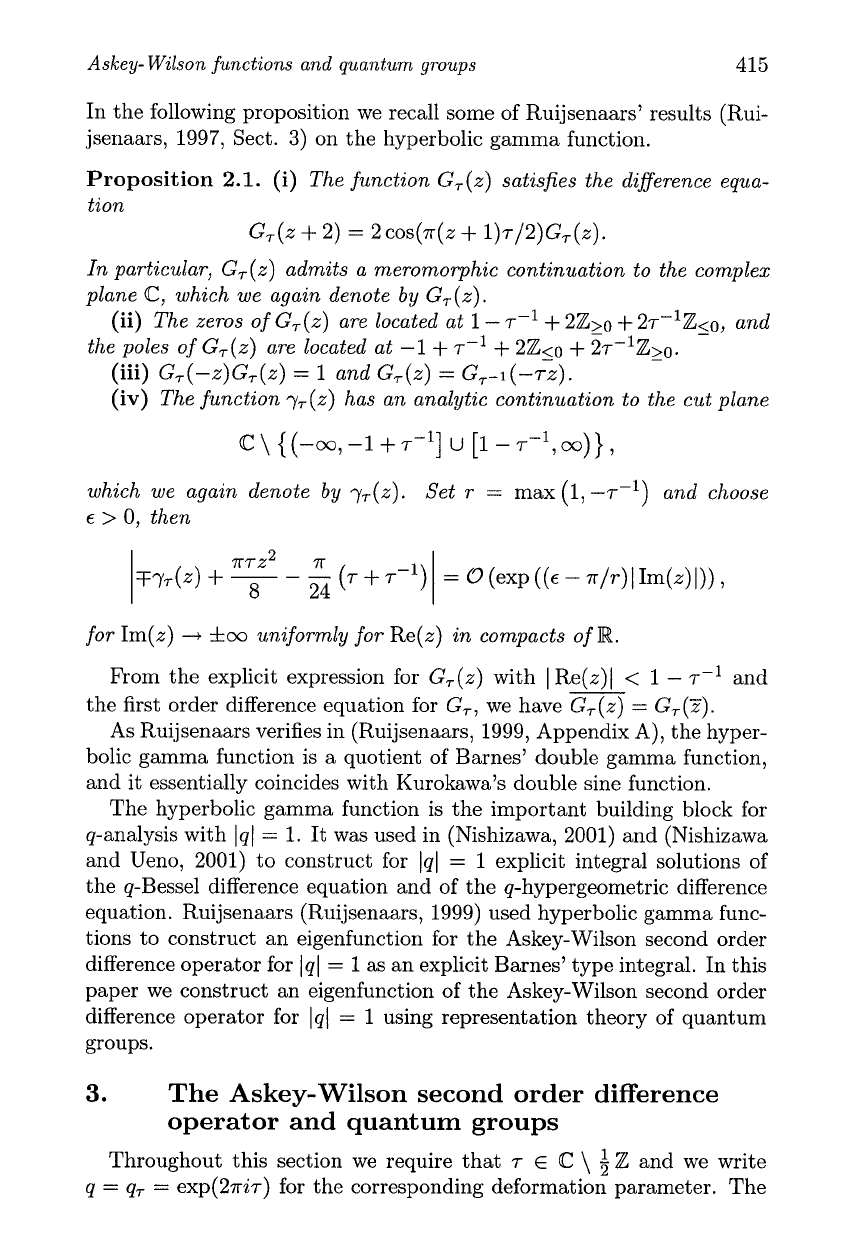
Aslcey- Wilson functions and quantum groups
415
In the following proposition we recall some of Ruijsenaars' results (Rui-
jsenaars, 1997, Sect.
3)
on the hyperbolic gamma function.
Proposition
2.1.
(i)
The function
GT(z)
satisfies the difference equa-
tion
GT(z
+
2)
=
2cos(n(z
+
1)7/2)G,(z).
In particular,
GT(z)
admits a meromorphic continuation to the complex
plane C, which we again denote by
G,(z).
(ii)
The zeros of
GT(z)
are located at
1
-
7-I
+
2Z>o
+
27-'Z<o,
-
and
the poles of
G,(z)
are located at
-1
+
7-'
+
2Z<o
-
+
%-'z>~.
-
(iii)
G,(-z)G,(z)
=
1
and
G,(z)
=
G,-I (-72).
(iv)
The function
y,(z)
has an analytic continuation to the cut plane
which we again denote by
y,(z).
Set r
=
max
(1,
-7-I)
and choose
E
>
0,
then
for
Im(z)
-t
f
co
uniformly for
Re(z)
in
compacts of
R.
7r7z2
7r
24
(7
+
7-l)
From the explicit expression for GT(z) with
I
Re(z)l
<
1
-
7-I
and
the first order difference equation for GT, we have GT(z)
=
GT(Z).
As Ruijsenaars verifies in (Ruijsenaars, 1999, Appendix A), the hyper-
bolic gamma function is a quotient of Barnes' double gamma function,
and it essentially coincides with Kurokawa's double sine function.
The hyperbolic gamma function is the important building block for
q-analysis with Iql
=
1.
It was used in (Nishizawa, 2001) and (Nishizawa
and Ueno, 2001) to construct for Iql
=
1
explicit integral solutions of
the q-Bessel difference equation and of the q-hypergeometric difference
equation. Ruijsenaars (Ruijsenaars, 1999) used hyperbolic gamma func-
tions to construct an eigenfunction for the Askey-Wilson second order
difference operator for Iql
=
1
as
an explicit Barnes' type integral. In this
paper we construct an eigenfunction of the Askey-Wilson second order
difference operator for Iql
=
1
using representation theory of quantum
groups.
=
0
(exp
((E
-
TIT)]
Im(z) I))
,
3.
The Askey-Wilson second order difference
operator and quantum groups
Throughout this section we require that
T
E
C
\
Z
and we write
q
=
q,
=
exp(2.rri.r) for the corresponding deformation parameter. The
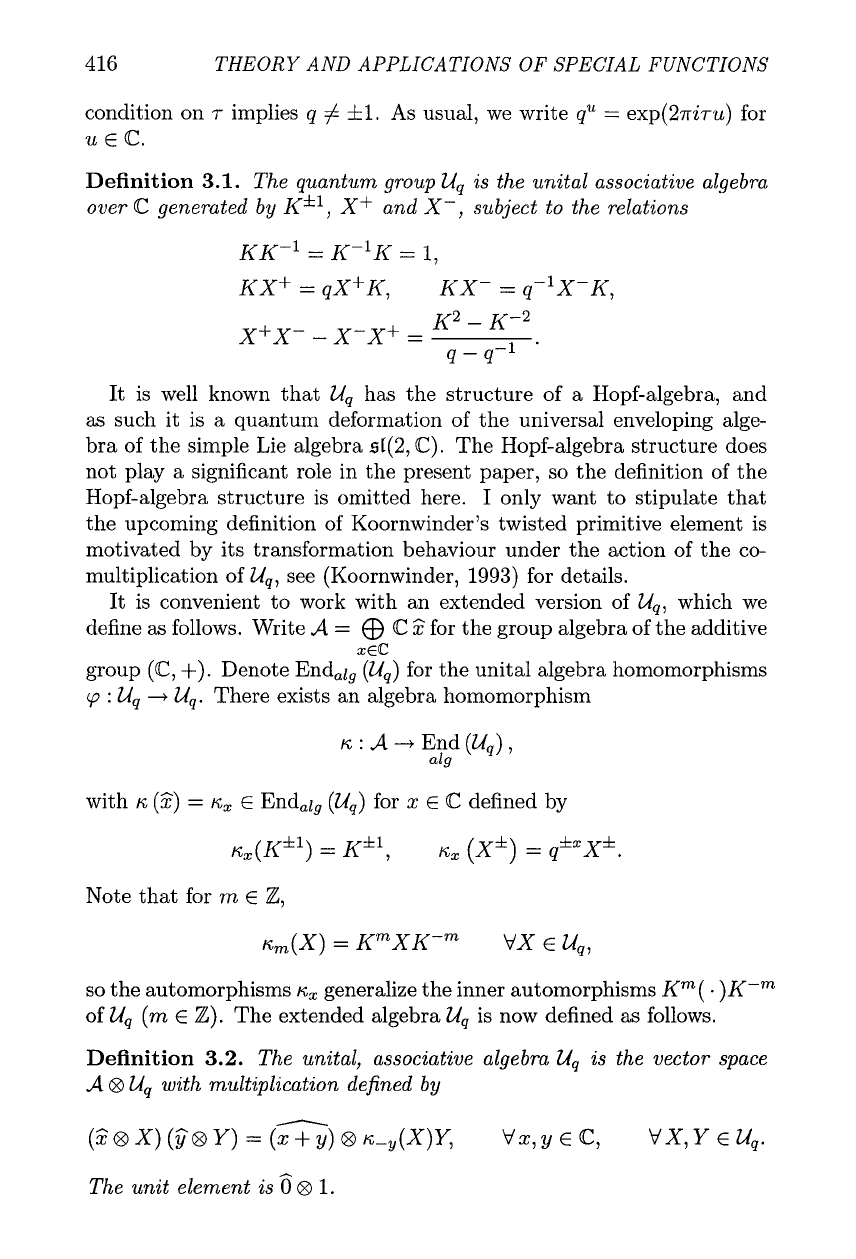
416
THEORY AND APPLICATIONS OF SPECIAL FUNCTIONS
condition on
T
implies
q
#
kl.
As usual, we write
qu
=
exp(27ri~u) for
u
E
C.
Definition
3.1.
The quantum group
Uq
is the unital associative algebra
over
C
generated by
Kf
l,
X+ and X-, subject to the relations
It is well known that Uq has the structure of a Hopf-algebra, and
as
such it is a quantum deformation of the universal enveloping alge-
bra of the simple Lie algebra d(2, C). The Hopf-algebra structure does
not play a significant role in the present paper, so the definition of the
Hopf-algebra structure is omitted here.
I
only want to stipulate that
the upcoming definition of Koornwinder's twisted primitive element is
motivated by its transformation behaviour under the action of the co-
multiplication of Uq, see (Koornwinder, 1993) for details.
It is convenient to work with an extended version of U,, which we
define
as
follows. Write
A
=
@
C
2
for the group algebra of the additive
---
XGC
group (C,
+)
.
Denote Endalg (U,) for the unital algebra homomorphisms
cp
:
Uq
t
Uq. There exists an algebra homomorphism
with
K.
(2)
=
IE,
E
Endalg (U,) for
x
E
C defined by
Note that for
m
E
Z,
so the automorphisms
6,
generalize the inner automorphisms
Km
(
-
)
K-m
of Uq
(m
E
Z).
The extended algebra Uq is now defined
as
follows.
Definition
3.2.
The unital, associative algebra
Uq
is the vector space
A
@
U,
with multiplication defined by
The unit element is
8
@
1.
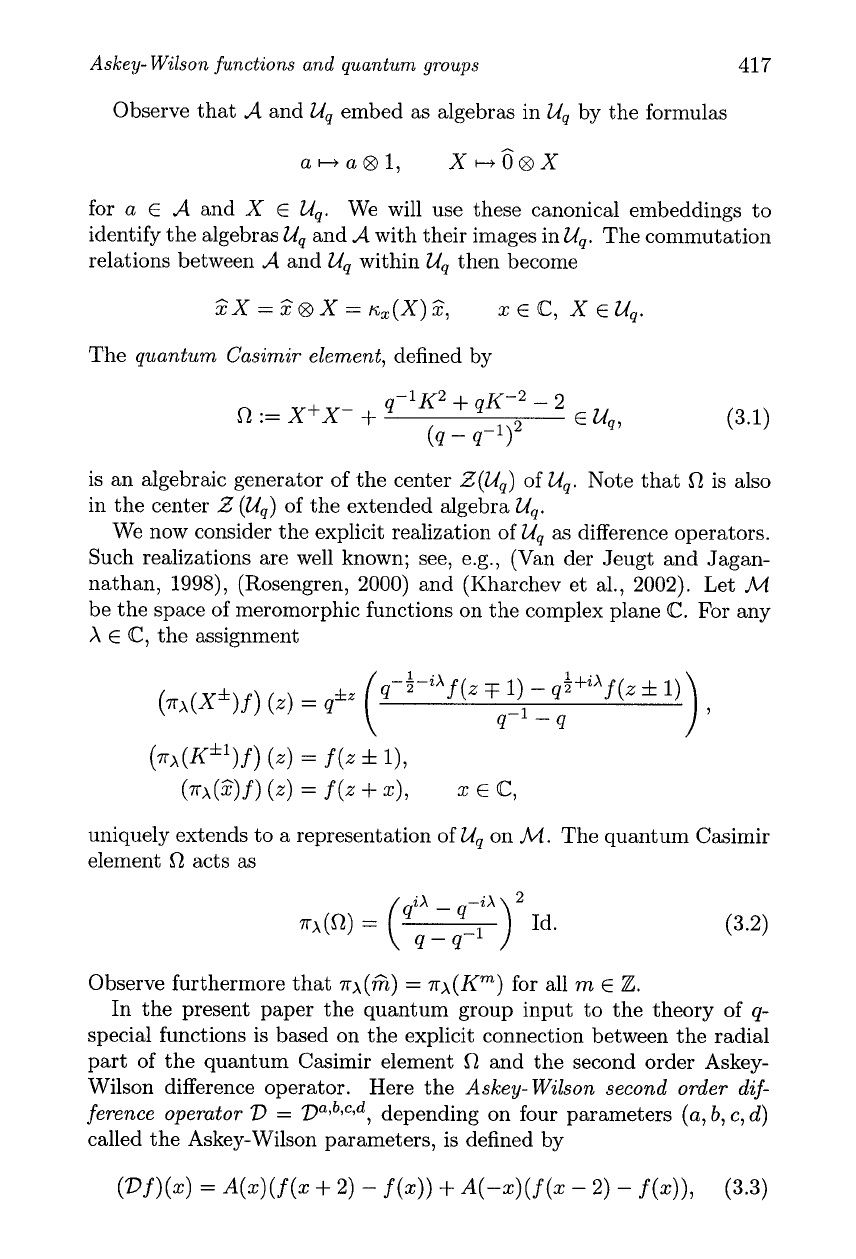
Aslcey- Wilson functions and quantum groups
417
Observe that
A
and Uq embed as algebras in Uq by the formulas
for a
E
A
and
X
E
Uq. We will use these canonical embeddings to
identify the algebras Uq and
A
with their images in Uq. The commutation
relations between
A
and Uq within Uq then become
The quantum Casimir element, defined by
is an algebraic generator of the center 2(Uq) of Uq. Note that
R
is also
in the center
Z
(Uq) of the extended algebra Uq.
We now consider the explicit realization of Uq as difference operators.
Such realizations are well known; see, e.g., (Van der Jeugt and Jagan-
nathan, 1998)) (Rosengren, 2000) and (Kharchev et al., 2002). Let
M
be the space of meromorphic functions on the complex plane
@.
For any
X
E
@,
the assignment
uniquely extends to a representation of Uq on
M.
The quantum Casimir
element
S2
acts as
Observe furthermore that .rrX(A)
=
.rrx(Km) for all
m
E
Z.
In the present paper the quantum group input to the theory of q-
special functions is based on the explicit connection between the radial
part of the quantum Casimir element
R
and the second order Askey-
Wilson difference operator. Here the Askey- Wilson second order dif-
ference operator
2)
=
~~,~y~,~,
depending on four parameters (a,
b,
c,
d)
called the Askey-Wilson parameters, is defined by

418
THEORY AND APPLICATIONS OF SPECIAL FUNCTIONS
with A(x)
=
A(x; a,
b,
c, d) the explicit function
cf. (Askey and Wilson, 1985). The radial part of R is computed with
respect to elements Yp
-
p,(p)
1
E
U, for
a,
p
E
C, where Yp is Koorn-
winder's (Koornwinder, 1993) twisted primitive element,
and p,(p) is the constant
Consider the five dimensional space
24,'
=
span
{x+,
X-,
K, K-',
1)
c
U,.
c
(3.6)
The radial part computation of R leads to the following result.
Proposition
3.3.
Let p,
a, a,
P
E
C.
For all x
E
C,
ZRK
=
ZR(x) K mod (Yp
-
pQ(p)) ZU,'
+
ZU,' (Y,
-
pg(a))
with R(x)
=
R(x;
a,
p,
p,
a) given explicitly by
where
1
-
qa+")
(1
-
q 2-a+x)
(1
-
qb+x)
(1
q2-b+z)
B
(x)
=
q-~
(
(1
-
q2")
(1
-
q2+2x)
1
C(x)
=
-A(x; a, b, c, d)
-
A(-x; a, b, c, d),
Here the Askey- Wilson parameters (a,
b,
c, d) are related to the parame-
ters
0,
P,
P,
0
by
(a, b,c,d)
=
(l+p+a, 1-p+a, l+a+p-P-a, 1-a-p-P-a). (3.7)
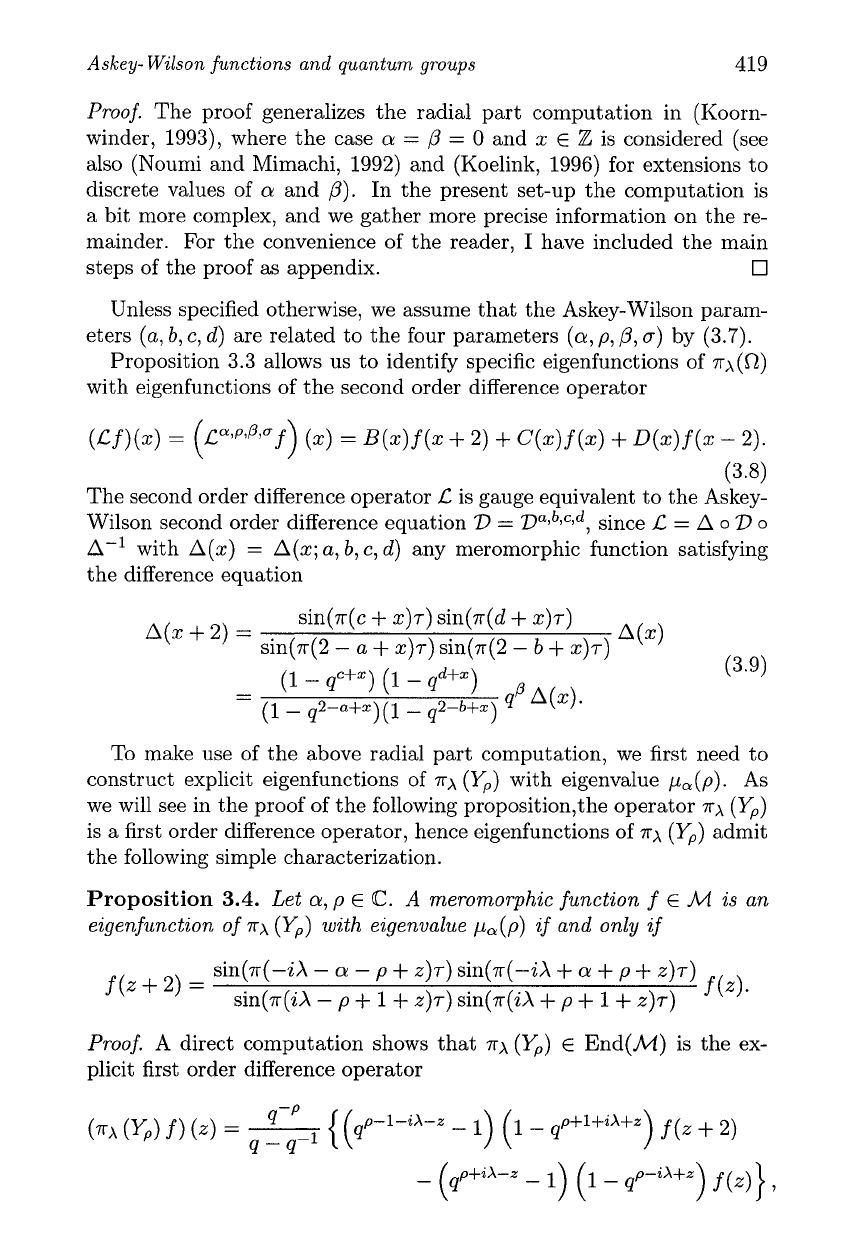
Askey- Wilson functions and quantum groups
419
Proof. The proof generalizes the radial part computation in (Koorn-
winder, 1993), where the case
a
=
P
=
0
and x
E
Z
is considered (see
also (Noumi and Mimachi, 1992) and (Koelink, 1996) for extensions to
discrete values of
a
and
p).
In the present set-up the computation is
a bit more complex, and we gather more precise information on the re-
mainder.
For the convenience of the reader, I have included the main
steps of the proof
as
appendix.
Cl
Unless specified otherwise, we assume that the Askey-Wilson param-
eters (a,
b,
c, d) are related to the four parameters (a, p,
P,
a)
by (3.7).
Proposition 3.3 allows us to identify specific eigenfunctions of nx(R)
with eigenfunctions of the second order difference operator
(Lf)(x)
=
(P@j~~~f)
(2)
=
B(x)f (5
+
2)
+
C(x)f (x)
+
D(x)f (x
-
2).
(3.8)
The second order difference operator
C
is gauge equivalent to the Askey-
Wilson second order difference equation
2)
=
Va~b~c~d, since
L
=
A
o
V
o
A-I with A(x)
=
A(x; a,
b,
c, d) any meromorphic function satisfying
the difference equation
To make use of the above radial part computation, we first need to
construct explicit eigenfunctions of
;rrx
(Yp) with eigenvalue pa (p)
.
As
we will see in the proof of the following proposition,the operator
;rrx
(Yp)
is a first order difference operator, hence eigenfunctions of
;rrx
(Yp) admit
the following simple characterization.
Proposition
3.4.
Let a,p
E
C.
A
meromorphic function
f
E
M
is an
eigenfunction of nx (Yp) with eigenvalue p,(p) if and only if
Proof. A direct computation shows that
;rrx
(Yp)
E
End(M) is the ex-
plicit first order difference operator
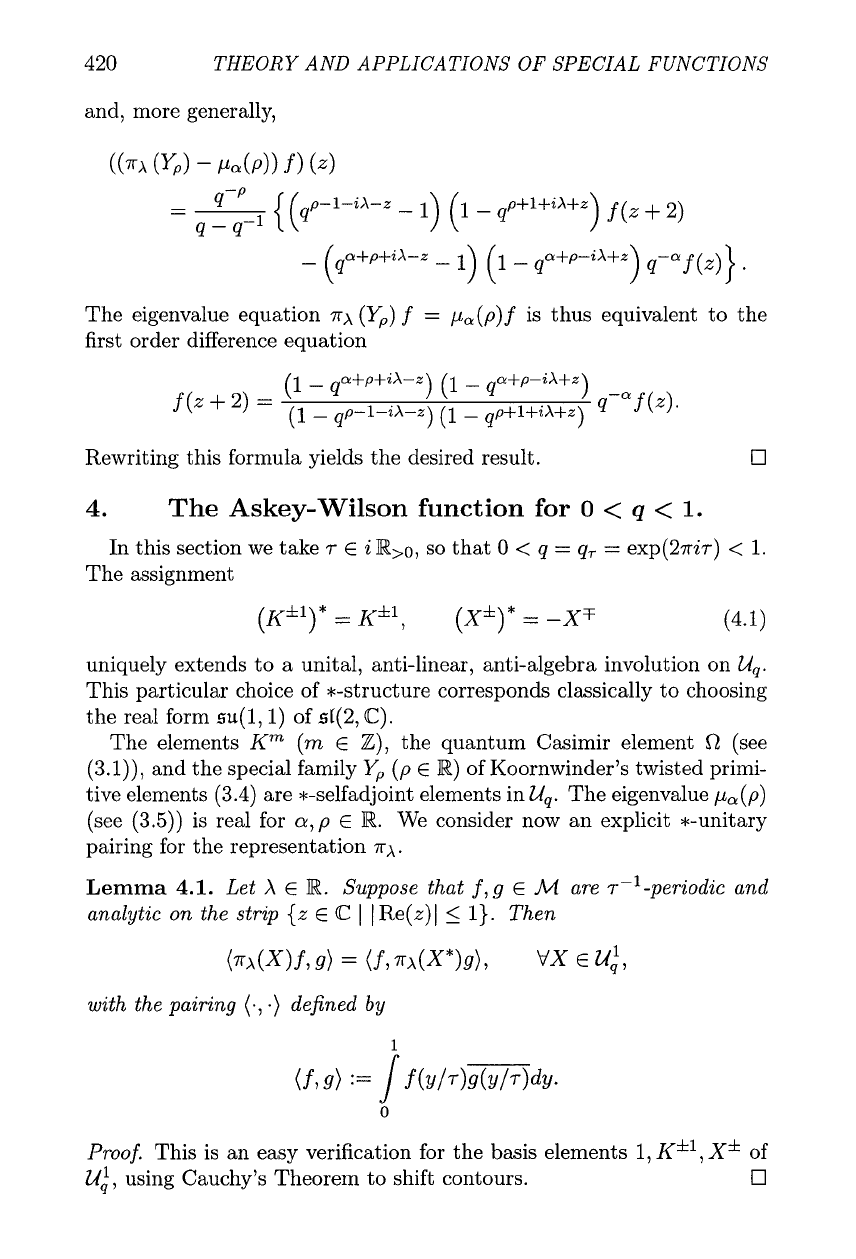
420
THEORY AND APPLICATIONS OF SPECIAL FUNCTIONS
and, more generally,
The eigenvalue equation nx (Yp)
f
=
p,(p)
f
is thus equivalent to the
first order difference equation
Rewriting this formula yields the desired result.
0
4.
The Askey-Wilson function for
0
<
q
<
1.
In this section we take
7
E
i
so that
0
<
q
=
q,
=
exp(2ni.r)
<
1.
The assignment
uniquely extends to a unital, anti-linear, anti-algebra involution on
Uq.
This particular choice of *-structure corresponds classically to choosing
the real form su(1,l) of sI(2, C)
.
The elements Km
(m
E
Z),
the quantum Casimir element
R
(see
(3.1)), and the special family Yp (p
E
R) of Koornwinder's twisted primi-
tive elements (3.4) are *-selfadjoint elements in
Uq.
The eigenvalue ,u,(p)
(see (3.5)) is real for
a,
p
E
R. We consider now an explicit *-unitary
pairing for the representation nx.
Lemma
4.1.
Let
X
E
R.
Suppose that f,g
E
M
are ~-'-~eriodic and
analytic on the strip {z
E
C
I
I
Re(z)l
5
1).
Then
with the pairing
(.,
.)
defined by
Proof. This is an easy verification for the basis elements
1,
Kf
l,
X'
of
24:)
using Cauchy's Theorem to shift contours.
0
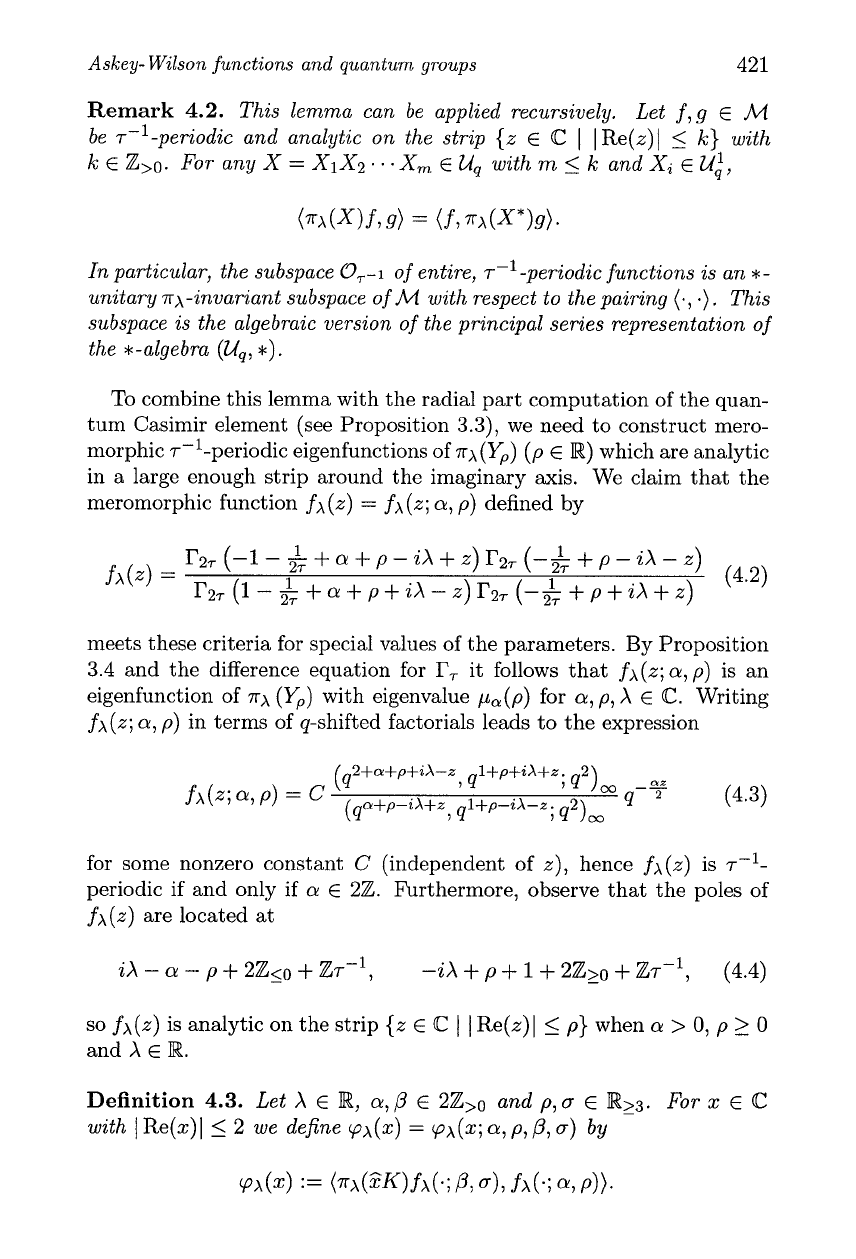
Askey- Wilson functions and quantum groups
421
Remark
4.2.
This lemma can be applied recursively. Let f,g
E
M
be
and analytic on the strip {z
E
(C
I
I
Re(z)l
5
k)
with
k
E
%>o. For any
X
=
XlXz...X,
E
I.I,
with
m
5
k
and
Xi
E
q,
In particular, the subspace
Or-I
of entire, ~-l-~eriodic functions is an
*-
unitary nx-invariant subspace of
M
with respect to the pairing
(a,
.)
.
This
subspace is the algebraic version of the principal series representation of
the *-algebra (Uq,
*).
To combine this lemma with the radial part computation of the quan-
tum Casimir element (see Proposition 3.3), we need to construct mero-
morphic T-'-periodic eigenfunctions of nx(Yp) (p
E
R) which are analytic
in a large enough strip around the imaginary axis. We claim that the
meromorphic function fx(z)
=
fx(z;
a,
p) defined by
meets these criteria for special values of the parameters. By Proposition
3.4 and the difference equation for
r,
it follows that fx(z; a,p) is an
eigenfunction of nx (Yp) with eigenvalue p,(p) for
a,
p,
X
E
C.
Writing
fx(z;
a,
p) in terms of q-shifted factorials leads to the expression
for some nonzero constant
C
(independent of z), hence fx(z) is T-l-
periodic if and only if
a
E
22. Furthermore, observe that the poles of
fx(z) are located at
so fx(z) is analytic on the strip {z
E
(C
I I
Re(z)l
<
p) when
a
>
0, p
2
0
and
X
E
R.
Definition
4.3.
Let
X
E
R,
a,P
E
22>0 and p,
a
E
ItL3.
For x
E
(C
with
I
Re(x)l
1
2 we define cpx(x)
=
cpx(x;
a,
p,
0,
a)
by

422
THEORY AND APPLICATIONS
OF
SPECIAL FUNCTIONS
Note that the matrix coefficient cpx(x) is given explicitly by
. .
and that cpx(x) is analytic on the strip {x
E
C
I I
Re(x)l
5
2). The quan-
tum group interpretation of this explicit integral leads to the following
result.
Theorem
4.4.
Let
X
E
R,
a,p
E
2Z>o and p,a
E
R>s. The matrix
coeficient cpx(x)
=
cpx(x;
a,
p, p,
a)
satisfies the second %der diflerence
equation
(.Lcpx> (2)
=
E(X)cpx(x)
for generic x
E
iR, with the eigenvalue E(X)
=
E(X; P) given
by
Proof. For the duration of the proof we use the shorthand notations
f
(z)
=
fx(z;
P,
a)
and g(z)
=
fx(z;
a,
p).
By the conditions on the
parameters, Yp is *-selfadjoint, p,(p) is real and the meromorphic func-
tions
f
(z) and g(z) are analytic on the strip {z
E
C
I
I
Re(z)l
5
3). By
Lemma
4.1
we thus obtain for any
X
E
L4:
and x
E
i
R,
and obviously also (xx (ZX (Yo
-
pp(a)))
f,
g)
=
0.
We conclude from
Proposition 3.3 that
On the other hand, (3.2) and Definition
4.3
implies that
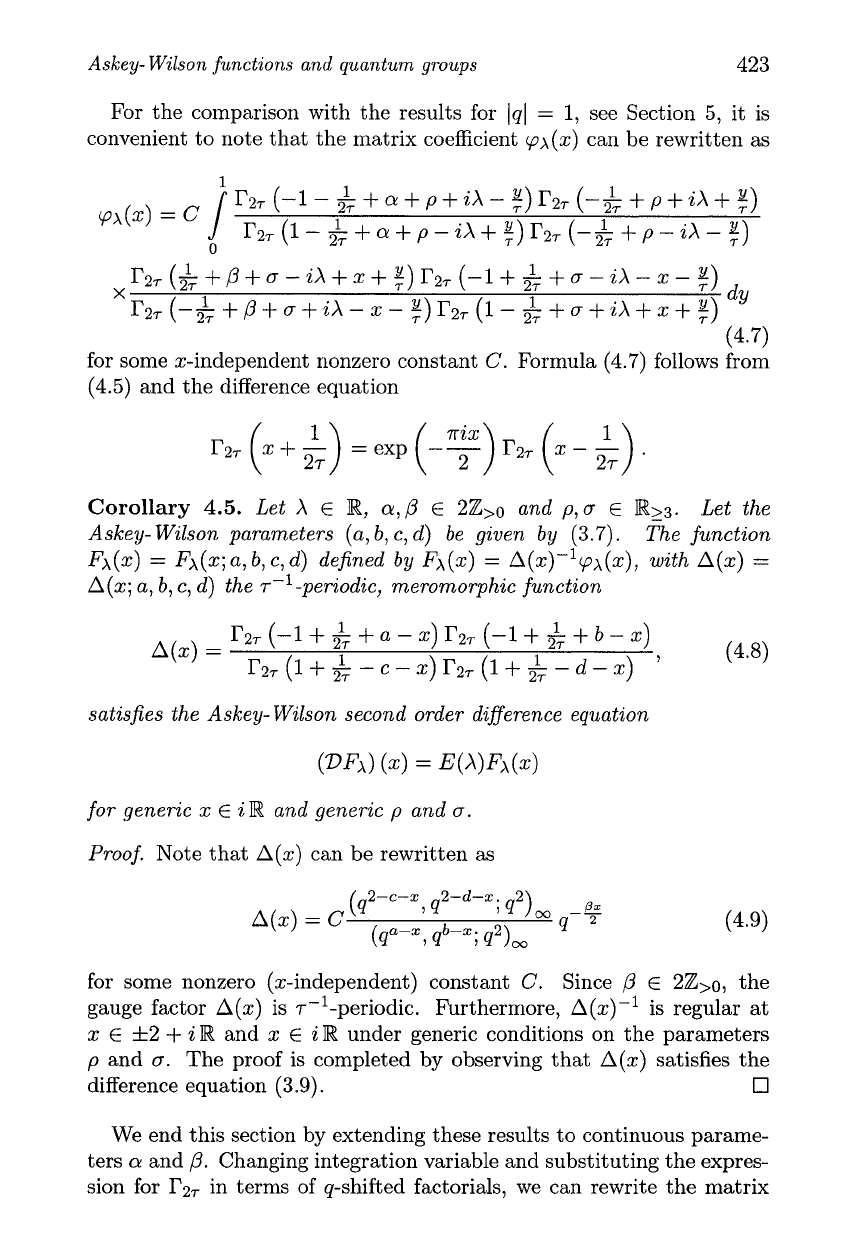
Aslcey- Wilson functions and quantum groups
423
For the comparison with the results for Iql
=
1,
see Section 5, it is
convenient to note that the matrix coefficient cpx(x) can be rewritten
as
I?,,
(&
+~+o-iX+x+
(-I+
&
+o-iX-X-
$)
X
r2~
(-&+~+o+i~-x-
$)r2,
(I-&+a+i~+x+$)
dy
(4.7)
for some x-independent nonzero constant
C.
Formula (4.7) follows from
(4.5) and the difference equation
,,
(x
+
k)
=
exp
(-F)
r2,
(x
-
k)
.
Corollary
4.5.
Let
X
E
R,
a,p
E
2Z>o and p,a
E
R>3.
Let the
Askey- Wilson parameters (a,
b,
c, d) be given
by
(3.7).
The function
FA(x)
=
FA(x; a,
b,
c,
d) defined by Fx(x)
=
A(x)-lcpx(x), with A(x)
=
A(x; a,
b,
c,
d)
the ~-'-~eriodic, meromorphic function
satisfies the Askey- Wilson second order digerence equation
for generic x
E
i
R and generic p and a.
Proof. Note that A(x) can be rewritten
as
for some nonzero (x-independent) constant
C.
Since
,8
E
2Z>o, the
gauge factor A(x) is ~-l-~eriodic. Furthermore, A(%)-I is regular at
x
E
f
2
+
i
R and x
E
i
R under generic conditions on the parameters
p and
o.
The proof is completed by observing that A(x) satisfies the
difference equation (3.9).
0
We end this section by extending these results to continuous parame-
ters
a
and
p.
Changing integration variable and substituting the expres-
sion for
r2,
in terms of q-shifted factorials, we can rewrite the matrix
